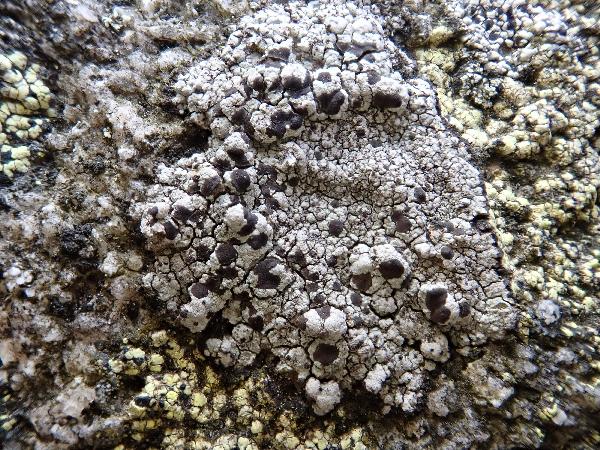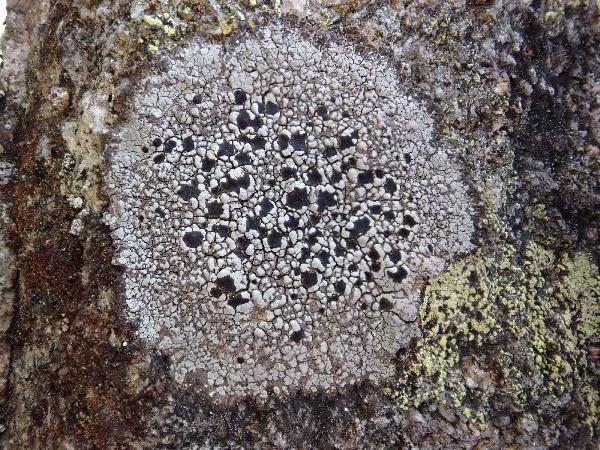Fuscidea kochiana (Hepp) V. Wirth & Vězda
in Wirth, Beitr. naturk. Forsch. Südwestdeutschl., 31: 92, 1972. Basionym: Lecidea kochiana Hepp - Lichen-Flora von Würzburg: 61, 1824.
Synonyms: Biatora indigula (Nyl.) Walt. Watson; Biatora kochiana (Hepp) Rabenh.; Biatora rivulosa var. kochiana (Hepp) Fr.; Lecanora mammillifera Stirt.; Lecidea coriacella Nyl.; Lecidea interludens Nyl.; Lecidea morosa Dufour; Lecidea rivulosa var. kochiana (Hepp) Schaer.
Description: Thallus crustose, episubstratic, rather thick, rimose-areolate, the areoles 0.5-2.5 mm wide, grey to brownish grey, often delimited by a dark prothallus. Medulla white, I-. Apothecia biatorine, innate, brown-black, sometimes faintly grey-pruinose (especially along the margins), usually irregular in outline and often elongate, 1-2.5(-3) mm across, with a flat disc, without a distinct proper margin. Proper exciple poorly developed, very thin; epithecium pale brown; hymenium colourless, very thick, scarcely delimited towards the hypothecium, 200-400 μm high; paraphyses simple or sparingly branched in upper part, 1.5-2 μm thick at mid-level, the apical cell clavate, to 5 μm wide. Asci 8-spored, clavate, developing at varying levels, with a thin external and internal K/I+ dark blue cap surrounded by a thick K/I+ pale blue apical cap, and with a K/I- apical tube in tholus, Fuscidea-type. Ascospores 1-celled, at first hyaline but becoming red-brown when overmature, broadly ellipsoid, 7.5-11 x 5-8 µm. Photobiont chlorococcoid. Spot tests: K-, C-, KC-, P-, UV+ bluish white. Chemistry: divaricatic acid.
Growth form: Crustose
Substrata: rocks
Photobiont: green algae other than Trentepohlia
Reproductive strategy: mainly sexual
Most common in areas with a humid-warm climate (e.g. most of Tyrrenian Italy)
Commonnes-rarity: (info)
Alpine belt: rather common
Subalpine belt: rather rare
Montane belt: very rare
Dry submediterranean belt: absent
Humid submediterranean belt: absent
Padanian area: absent
pH of the substrata:
1 2 3 4 5
Solar irradiation:
1 2 3 4 5
Aridity:
1 2 3 4 5
Eutrophication:
1 2 3 4 5
Poleotolerance:
0 1 2 3
Altitudinal distribution:
1 2 3 4 5 6
Rarity
absent
extremely rare
very rare
rare
rather rare
rather common
common
very common
extremely common
Loading data...
Occurrence data
Predictive map
Growth form: Crustose
Substrata: rocks
Photobiont: green algae other than Trentepohlia
Reproductive strategy: mainly sexual
Most common in areas with a humid-warm climate (e.g. most of Tyrrenian Italy)
Commonnes-rarity: (info)
Alpine belt: rather common
Subalpine belt: rather rare
Montane belt: very rare
Dry submediterranean belt: absent
Humid submediterranean belt: absent
Padanian area: absent
pH of the substrata:
| 1 | 2 | 3 | 4 | 5 |
Solar irradiation:
| 1 | 2 | 3 | 4 | 5 |
Aridity:
| 1 | 2 | 3 | 4 | 5 |
Eutrophication:
| 1 | 2 | 3 | 4 | 5 |
Poleotolerance:
| 0 | 1 | 2 | 3 |
Altitudinal distribution:
| 1 | 2 | 3 | 4 | 5 | 6 |
Rarity
absent
extremely rare
very rare
rare
rather rare
rather common
common
very common
extremely common
Loading data...
Occurrence data
Predictive map

















